Timeline of LGBTQ+ Representation in Advertising

In 2022, LGBTQ+ representation in advertising has come a long way. With themed Pride merch and targeted ad campaigns, more and more companies are showing solidarity with the LGBTQ+ community.
The world is starting to see that the queer community is deeply influential with a powerful voice. However, when it comes to how LGBTQ+ people are represented in advertisements, there’s still progress to be made.
People in the queer community make up 7.1% of the population (including over 20% of Generation Z). The advertising representation still falls short of these numbers. Four in 10 people in the LGBTQ+ community feel they aren’t fairly represented in brands. Another 31% say they feel that marketing portrays them badly.
And while queer-themed advertisements aren’t hard to find during Pride, the power of LGBTQ+ visibility goes far beyond the month of June.
Getting queer representation in advertisements right is more important than ever. Statistics show that LGBTQ-inclusive ads can improve brand recall, inspire more purchases, and build a more progressive company image. While the global queer community’s purchasing power is estimated at $3.7 trillion, it isn’t all about the money. Making queer stories more visible in advertising is all about making equality a priority for your brand and showing your audience that you don’t just see them for who they are — you value them for it too.
To better understand how far we’ve come — and how far we still have to go — it helps to take a look back at our history. What do the past decades have to tell us about LGBTQ representation? And which campaigns made a powerful impact on the representation of queer people?
In this article, we’ll explore the evolution of LGBTQ+ representation in advertising, from the 1980s until now.
The 1980s
The 1980s were marked by a devastating, unchecked crisis: the AIDS epidemic. With the spread of AIDS came a resurgence of widespread intolerance against LGBTQ+ people.
The AIDS crisis dealt a significant blow to LGBTQ+ representation in advertising. Brands that chose to represent gay and lesbian people were taking a huge risk. They feared that reaching out to the community would alienate their larger audience, or even lead to serious backlash.
However, that doesn’t mean that representation didn’t exist. In 1986, the vodka brand Absolut created an ad that included the artwork of Keith Haring, an AIDs advocate who was openly gay at the time. The symbolism in the art wasn’t openly queer, which meant that it could pass as a typical advertisement to the general public. For the LGBTQ+ community though, it was a powerful statement of support.
To draw a correlation to the present day, another vodka brand, Stoli, 40 years later produced an ad honoring politician and gay rights activist Harvey Milk with a specially themed bottle–and a robust ad campaign to support the launch.
Other brands also broke the mold in the late 1980s, like Benetton with their “United Colors of Benetton” campaign featuring the first representation of lesbians in a mainstream advertisement.
Brands that included LGBTQ+ images, symbolism, and characters faced boycotts — or even death threats — for their campaigns. Even though their support was often subtle, these ads still shocked the world with their mainstream representation in the face of a widely homophobic culture.
The 1990s
With the continuing taboo against gay representation and the backlash from queer-friendly ads in the 1980s, brands continued to shy away from the overt representation of LGBTQ+ people in most advertisements.
Some brands continued to show their support while still keeping under the radar to avoid mainstream attention. Subaru was a notable example of this. They targeted the lesbian community through taglines like: “We’re completely comfortable with our orientation” or “It’s not a choice, it’s just how we’re built.”
It wasn’t until 1996 that the face of queer advertising changed forever. It was IKEA that first made waves with their commercial that featured an openly gay couple. Aired during daytime TV, this commercial made waves across the nation. As one of the first representations of a gay couple taking part in normal activities, like shopping for furniture, this commercial paved the way toward LGBTQ+ acceptance during this era.
For the first time, mainstream America saw a gay couple portrayed the same as any other couple in a healthy, romantic relationship.
The 2000s
The turn of the century came with significant progress for LGBTQ+ acceptance. But with gay marriage still illegal and a lingering stigma surrounding queer identities, most brands played it safe.
Despite the growing presence of gay characters in early 2000s entertainment, companies still risked backlash for showing explicit LGBTQ+ inclusivity. When brands did feature LGBTQ+ people, they typically focused on white and upper-class figures — rarely people of color. Most representations of transgender people were mainly negative, with almost no representation for non-binary identities.
However, it was clear that the tides were starting to turn for LGBTQ+ advertising representation. In a subtle show of support, Washington Mutual featured an ad with a checkbook that had the names of two men on top. Levi’s took a more direct approach with a commercial that had two distinct endings, one for a straight audience and one for a gay audience. While in one ending, they showed a classic “guy gets girl” trope, the other featured an ending where two men ended up in a relationship.
Many brands still proceeded with caution in the early 2000s, but this decade also came with more direct and open representations of queer identities. Same-sex couples weren’t the norm just yet, but these advertisements helped pave the way for future advocacy.
The 2010s
By the 2010s, LGBTQ+ identities were becoming more normalized. It was common to see same-sex couples represented in commercials, print advertisements, and even billboards.
At this point, the market for LGBTQ+ consumers grew to $743 billion, and companies were starting to take notice. Major brands like Cheerios, McDonald’s, and Ray Ban started to include LGBTQ+ storylines and imagery in their marketing.
The passing of the Marriage Equality Act in 2015 was a powerful turning point for representation in all forms of media. Advertisers increased the number of ads featuring LGBTQ+ images, and soon began incorporating representations of transgender and non-binary people too. Nike put the spotlight on transgender athlete Chris Moser in 2016, while Coke ran an ad including non-binary pronouns.
In fact, brands have become so invested in queer-friendly ads that some in the community are pointing toward what they call “rainbow washing.” This is when brands project the image of inclusivity, but their actions don’t support their words. For example, in 2018, AT&T donated $1 million to The Trevor Project during Pride month — while also donating more than $2.75 million in the same year to politicians with anti-LGBTQ+ policies.
The State of LGBTQ+ Representation Today
While the community has faced its fair share of setbacks, it’s safe to say that LGBTQ+ representation is reaching new heights. Advertising can act as a mirror for society, but it isn’t entirely passive either. The kind of images and stories represented in advertisements can make waves in popular culture, even changing the way people see the world.
The more LGBTQ+ faces and voices we see in advertisements, the more our society shifts towards progress. While challenges for the LGBTQ+ community are far from over, the rise of representation in advertisements points toward a hopeful future.
Do More with Video
Learn how we can help you produce more quality videos affordably and at scale.


